| Eskimo umiak |
|---|
 |
Gold Panning with Andy Wescott
(Posted August 26, 2000, © Herbert E.
Lindberg)
Day 3 (July 16) began with a visit to the University of Alaska Museum. (About a third of the group had signed up to fly to Barrow instead, but spent most of the morning sitting in the Fairbanks airport waiting for the weather to clear in Barrow, which it didn't.) The museum was very interesting and worthwhile, but not something to be reported in detail. I did snap one picture of an Eskimo umiak, because I had just read about how the Eskimos used them to hunt and kill whales. This umiak was made with mill-sawn boards in addition to the animal skins and thongs used by Eskimos centuries ago, but you get the idea.
| Eskimo umiak |
|---|
 |
In Michner's book Alaska he describes how about six to eight Eskimos would paddle in such a umiak through the icy waters of the Bering Straight to kill a whale, before the whale killed them! It's hard to imagine the courage these men had in paddling directly over a whale many times the size of this tiny craft to spear it with primitive (but very sophisticated) harpoons. Then they would paddle after the whale and spear it again, and again. Now it took real courage to approach the whale. But they did, and basically wore the whale down until it was dead. Then they had to drag it to shore before it disappeared into the vast ocean. All this courage and energy was inspired by one thought, survival. Without a whale to provide food and oil, their tribal group would never survive the long Alaskan winter.From the museum the motor coach took us to the Gold Rush Gold Camp to pan for gold. Living in the Gold Country of California, there wasn't much new for Mary and me, but it was good fun because the owner, Andy Wescott, was a true character as well as entrepreneur. It was only a few hundred yards from the parking lot to the panning area, but Andy had laid track and pulled us in some open cars to the "diggin's." The track was used for more than this, however, because in addition to the tourist business Andy used the track to transport ore and equipment to a working mine nearby.
| People train to the "Gold Diggin's" |
|---|
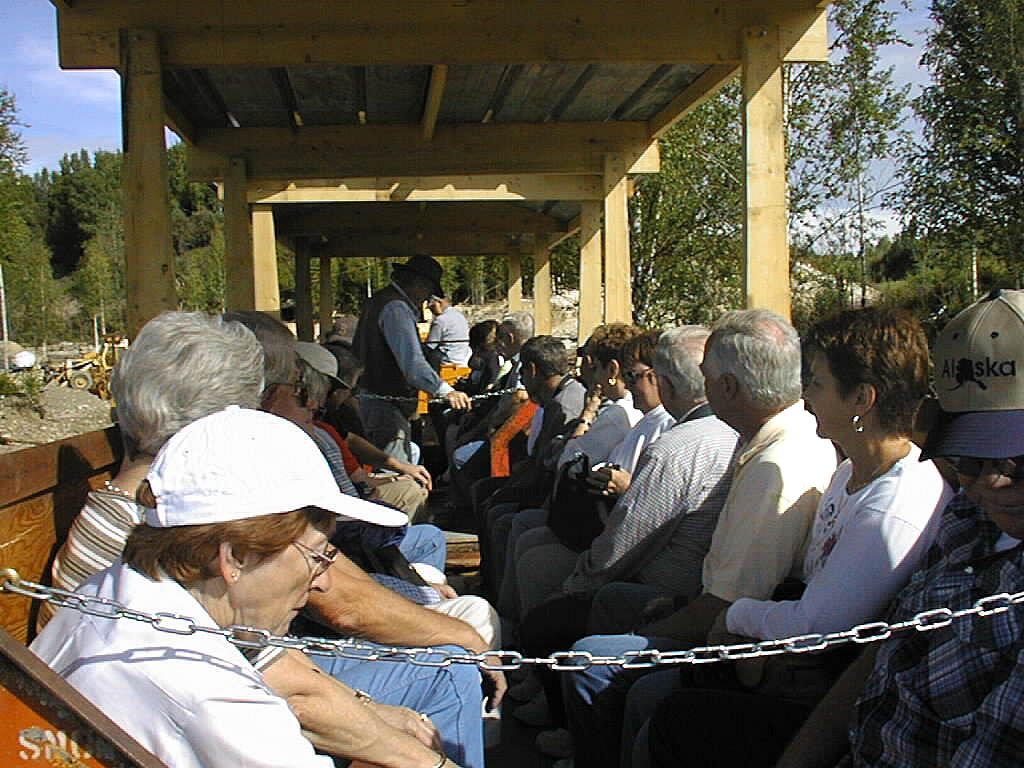 |
Though only a couple hundred yards, the train ride was an unintended adventure. The couplers between cars were made of old steel rod welded to an angled bar to lift the rod out of a similarly kluged hole in a plate welded to the next car (kluge: a quick and unsophisticated solution to a problem at hand). The operator of the diesel engine pulling this entourage used only two brake positions: off and full on. When we came to a switch in the track, he stopped the train. Although the velocity change was only a few miles per hour, the acceleration was nearly infinite. The car in front of us came to a sudden stop and our car slammed to a stop via the primitive coupler. Then the engine began to pull us again followed by another banging stop. Being and engineer, I was seriously worried about the coupler rod being sheared off by these massive forces. This would have been no big deal, except that the track behind us sloped seriously downward. If the rod did shear off, our car would have accelerated to more than 40 mph before slamming into who knows what. I mentioned all this jokingly, but softly, to those around me. I don't know about them, but I was in the front of the car with my body braced to jump train.The train arrived at a sluice box with a platform built around it for guests to observe its operation. After Andy gave us a short, and very humorous, talk on placer mining, he shouted down to one of his crew to bring up a load of gold-bearing diggings that had been taken from his mine. Soon a front loader rumbled up the hill to scoop diggings from a huge pile and dump the scoopful into a holding box at the top of the sluice box.
| Andy Wescott tells us about placer mining with a sluice box |
|---|
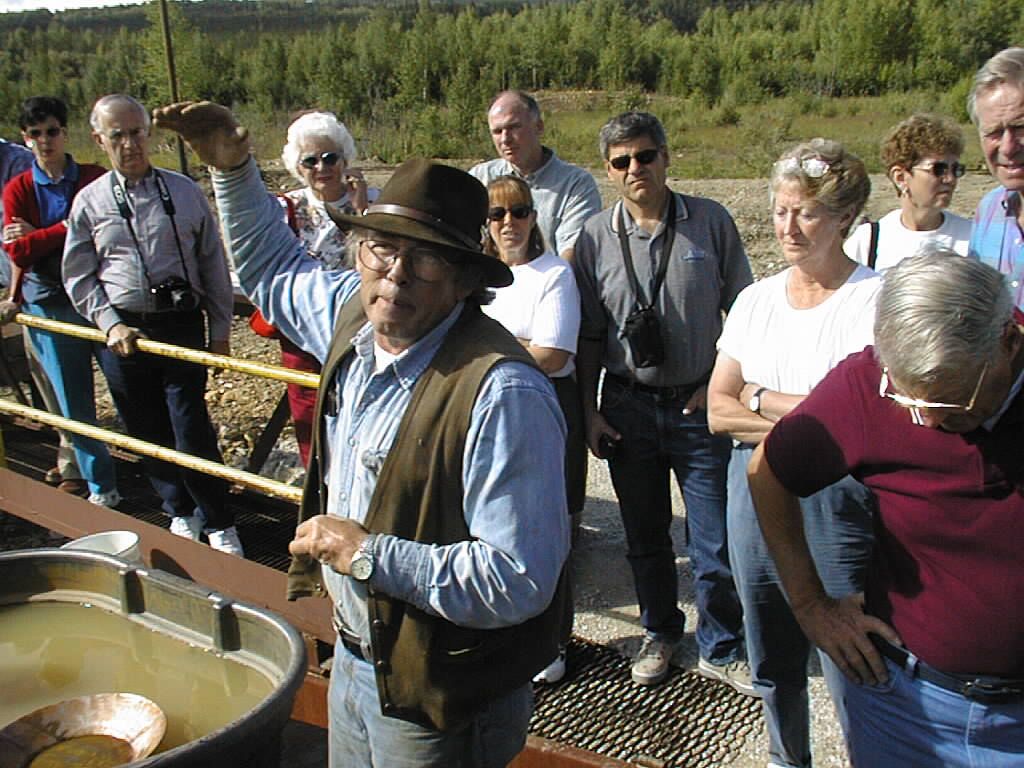 |
Then Andy turned on a generous water supply (gold mining is a water-intensive industry) and the guy from the front loader began to push the diggings into the sluice box to mingle with the water (in picture below). The water washes the fine material from the mixture of rock, gravel and dirt while the sluice box crew push the diggings down the box. Tom Klinger (in the maroon shirt above) "volunteered" to be one of the crew and dragged the diggings past the slats across the bottom of the box that accumulate fine, heavy material, including gold, that sinks. Andy told us that most of this gravity-separation process takes place very quickly near the top of the sluice box where the diggings are first pushed in. Therefore, the base of the sluice box at this point is covered with a piece of Astroturf, which catches the heavy fines that are washed to the bottom.
| Dragging gold diggings into a sluice box |
|---|
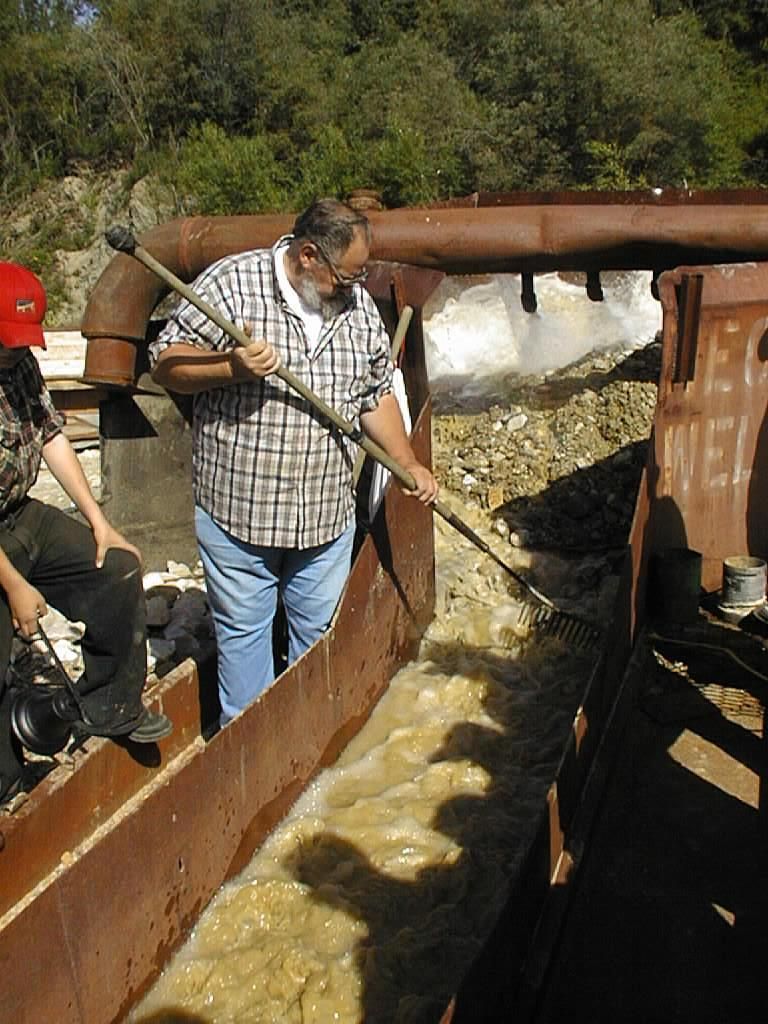 |
After several cubic feet of diggings were washed, Andy turned off the water and dug down with his hands to carefully remove the Astroturf mat. Then he dipped the mat into the wash tub of water and rolled water back and forth across it to wash the gold-bearing dirt into the water. In the picture below he shows us the resulting slurry that he scooped from the bottom of the washtub.
| Andy shows us the gold dirt washed from the Astroturf mat |
|---|
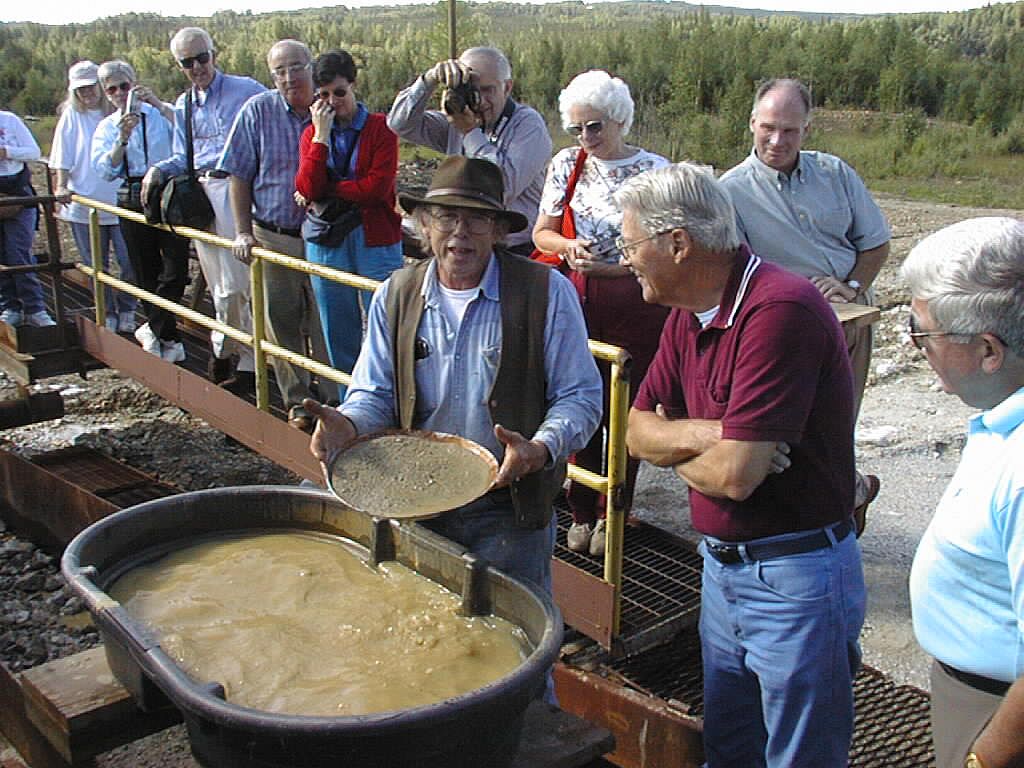 |
Then Andy performed his real magic, hand panning the slurry. With a skill from years of panning, he swirled the pan to encourage the gold to drop to the bottom while pouring off the unwanted dirt and rocks. In the final stage, he slowly tipped the pan to allow any remaining dirt, rocks and water to go to the down side while the gold remained held by friction to the up side of the pan bottom. We could see the gold dust but it's too small to see in the picture below unless you know it's there. Then Andy divided the gold among Tom, the front loader operator, another volunteer helper, and himself. He did this by pushing his fingers against the gold dust and then scraping what stuck to his fingers into 35-mm film canisters for each recipient. He repeated this process until the pan was empty of gold. Later we found that each container had about $10 to $20 worth of gold dust.Then Andy reminded us that there was still a substantial amount of gold remaining in the washtub and along the slats at the bottom of the rest of the sluice box, which he and his crew would periodically retrieve.
| After hand panning, only this remained (gold is in shadow on the up side of pan bottom) |
|---|
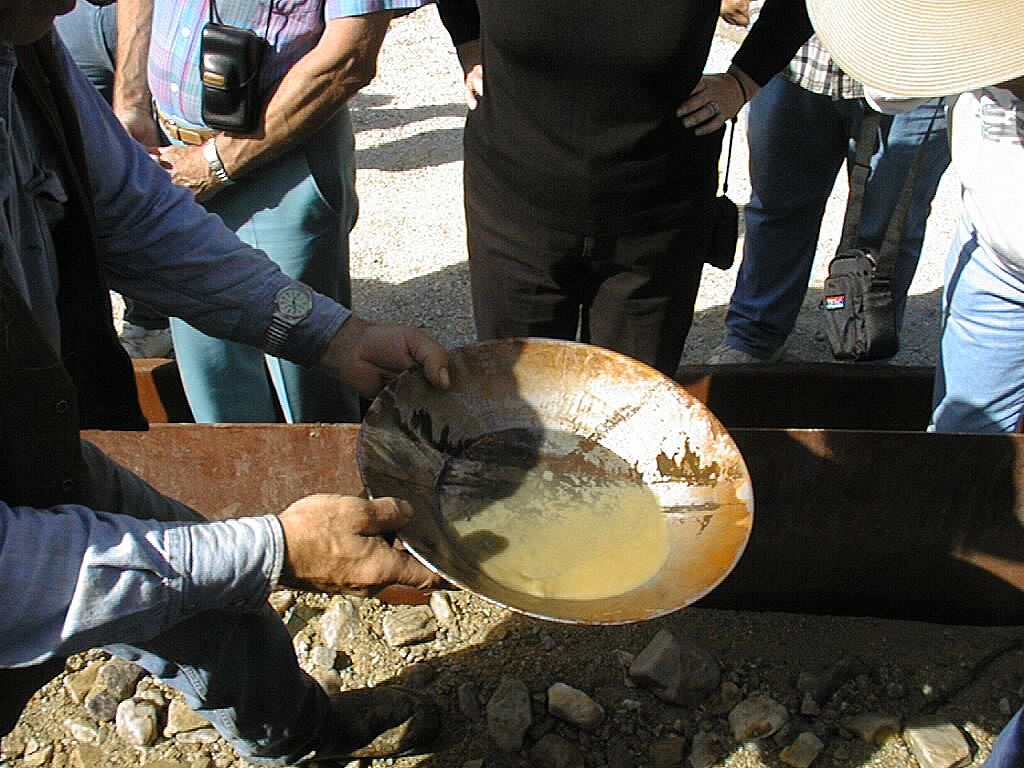 |
After this demonstration, Andy led us to another platform that had rows of water tubs around its perimeter that we all (about 50 of us, including a few independent tourists) used to try our hand at gold panning. We were each given a sack of dry gold dirt that we poured into our pans and then washed. Many were able to separate out measurable amounts of gold, ranging from $10 of dust to several who found $30 to $50 nuggets. Again, Andy told us that he and his crew periodically empty the wash tubs and pan out any remaining gold, which is a lot because of panners like me!How did I fare? I got the golden klutz award, because after carefully swirling my pan and pouring off soil and rocks, I was so far behind everyone else that I began to swish my pan from side to side to get out the rocks. I learned that this is a no-no -- I was throwing out the gold with the wash water. When one of the resident experts helped me with the final phase of panning, there were only a few very small bits of gold remaining, too small to bother putting into my 35-mm canister. Maybe I'll try again at home in the Yuba river!
Things got pretty boring after the panning, as about 40 people lined up to have Andy pour gold out of each 35-mm canister, weigh it, estimate its worth, and put it back into the canister or into clear glass neckchain momentos that he sold. Below is Mary and I killing time among Andy's junk at the side of his store.
| Mary and I killing time amongst Andy's junk |
|---|
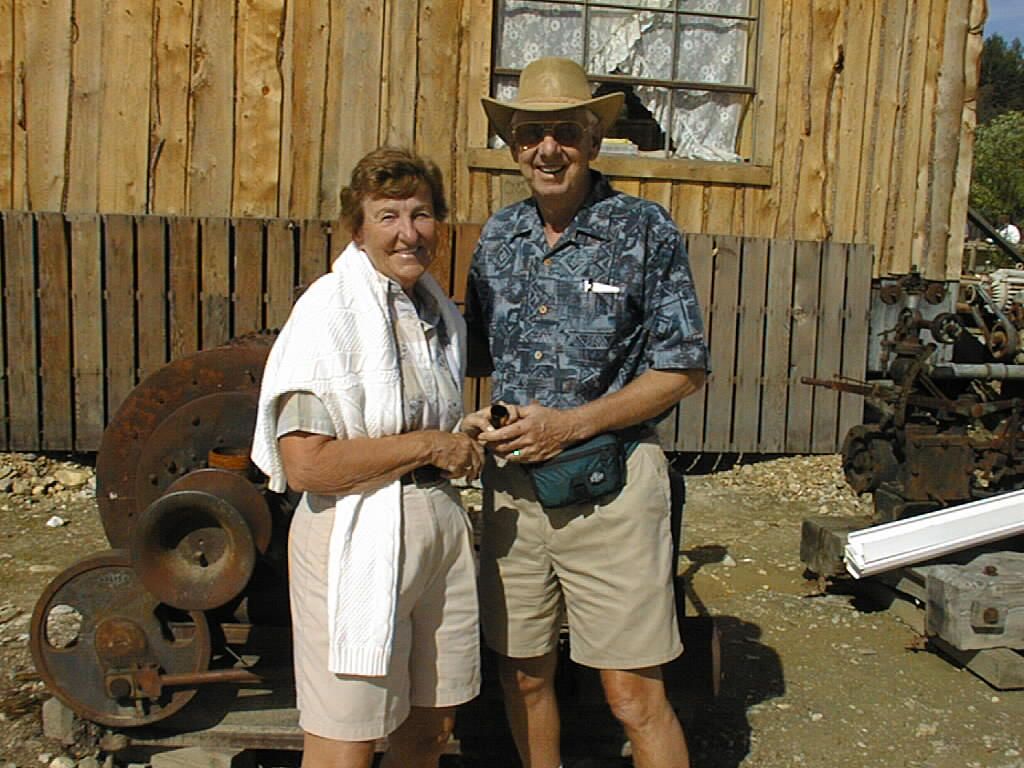 |
Continue to Goldstream Dredge No. 8 - - - Return to Alaska hub page - - - Return to Home Page Top